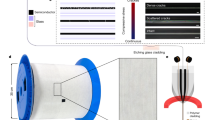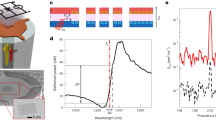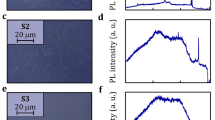Abstract
The combination of conductors, semiconductors and insulators with well-defined geometries and at prescribed length scales, while forming intimate interfaces, is essential in most functional electronic and optoelectronic devices. These are typically produced using a variety of elaborate wafer-based processes, which allow for small features, but are restricted to planar geometries and limited coverage area1,2,3. In contrast, the technique of fibre drawing from a preformed reel or tube is simpler and yields extended lengths of highly uniform fibres with well-controlled geometries and good optical transport characteristics4. So far, this technique has been restricted to particular materials5,6,7 and larger features8,9,10,11,12. Here we report on the design, fabrication and characterization of fibres made of conducting, semiconducting and insulating materials in intimate contact and in a variety of geometries. We demonstrate that this approach can be used to construct a tunable fibre photodetector comprising an amorphous semiconductor core contacted by metallic microwires, and surrounded by a cylindrical-shell resonant optical cavity. Such a fibre is sensitive to illumination along its entire length (tens of meters), thus forming a photodetecting element of dimensionality one. We also construct a grid of such fibres that can identify the location of an illumination point. The advantage of this type of photodetector array is that it needs a number of elements of only order N, in contrast to the conventional order N2 for detector arrays made of photodetecting elements of dimensionality zero.
This is a preview of subscription content, access via your institution
Access options
Subscribe to this journal
Receive 51 print issues and online access
$199.00 per year
only $3.90 per issue
Buy this article
- Purchase on Springer Link
- Instant access to full article PDF
Prices may be subject to local taxes which are calculated during checkout




Similar content being viewed by others
References
Sze, S. M. Semiconductor Devices: Physics and Technology 2nd edn (John Wiley, New York, 2001)
Sedra, A. S. & Smith, K. C. Microelectronic Circuits (Oxford Univ. Press, Oxford, 2003)
Chuang, S. L. Physics of Optoelectronic Devices (John Wiley, New York, 1995)
Sanghera, J. S. & Aggarwal, I. D. (eds) Infrared Fiber Optics (CRC Press, New York, 1998)
Harrington, J. A. A review of IR transmitting, hollow waveguides. Fiber Integrated Opt. 19, 211–227 (2000)
Katagiri, T., Matsuura, Y. & Miyagi, M. Metal-covered photonic bandgap multilayer for infrared hollow waveguides. Appl. Opt. 41, 7603–7606 (2002)
Large, M. et al. Microstructured optical fibers: Why use polymers? Proc. 29th Eur. Conf. on Opt. Comm. (ECOC'03 Rimini), 1014–1017 (2003); available at 〈http://www.oftc.usyd.edu.au/?section=fibre&fibre=mpof#2〉
Broeng, J., Mogilevstev, D., Barkou, S. E. & Bjarklev, A. Photonic crystal fibers: A new class of optical waveguides. Opt. Fiber Technol. 5, 305–330 (1999)
Eggleton, B. J., Kerbage, C., Westbrook, P. S., Windeler, R. S. & Hale, A. Microstructured optical fiber devices. Opt. Express 9, 698–713 (2001)
van Eijkelenborg, M. A. et al. Microstructured polymer optical fiber. Opt. Express 9, 319–327 (2001)
Allan, D. C. et al. in Photonic Crystal and Light Localisation in the 21st Century (ed. Soukoulis, C. M.) 305–320 (Kluwer Academic, Dordrecht, 2001)
Knight, J. C. Photonic crystal fibres. Nature 424, 847–851 (2003)
Yeh, P., Yariv, A. & Marom, E. Theory of Bragg fiber. J. Opt. Soc. Am. 68, 1196–1201 (1978)
Fink, Y. et al. A Dielectric omnidirectional reflector. Science 282, 1679–1682 (1998)
Kuriki, K. et al. Hollow multilayer photonic bandgap fibers for NIR applications. Opt. Express 12, 1510–1517 (2004)
Hart, S. D. et al. External reflection from omnidirectional dielectric mirror fibers. Science 296, 510–513 (2002)
Temelkuran, B., Hart, S. D., Benoit, G., Joannopoulos, J. D. & Fink, Y. Wavelength-scalable hollow optical fibres with large photonic bandgaps for CO2 laser transmission. Nature 420, 650–653 (2002)
Acknowledgements
M.B. thanks P. H. Prideaux for teaching him optical fibre drawing. We also thank N. Orf for glass transition temperature measurements, Y. Kuriki for taking SEM micrographs, and K. Kuriki for providing PEI polymer films. This work was supported in part by DARPA/Carrano and DARPA/Griggs, DARPA QUIST, the ARO, the ONR, the AFOSR HEL-MURI, the US DOE, the ISN, and the Materials Research Science and Engineering Center (MRSEC) programme of the NSF (with the use of their Shared Experimental Facilities).
Author information
Authors and Affiliations
Corresponding authors
Ethics declarations
Competing interests
The authors declare that they have no competing financial interests.
Supplementary information
Supplementary Notes
Construction of a two-dimensional photoconducting transparent fibre web. (DOC 26 kb)
Supplementary Figure 1
A two-dimensional photoconducting transparent fibre web. (JPG 96 kb)
Supplementary Video 1
Two-dimensional O(N) photoconducting fiber web tracking the location of a light beam: The photodetecting fibre web is shown beside a computer screen that displays the user interface for the program. When the light beam, from a flash light, is moved across the grid, a spot is generated and displayed on the computer screen at the corresponding location on the virtual grid. Once the beam is removed the point on the screen disappears, signifying that all the voltage drops on the fibers have returned to their dark values. (MPG 4304 kb)
Rights and permissions
About this article
Cite this article
Bayindir, M., Sorin, F., Abouraddy, A. et al. Metal–insulator–semiconductor optoelectronic fibres. Nature 431, 826–829 (2004). https://doi.org/10.1038/nature02937
Received:
Accepted:
Issue Date:
DOI: https://doi.org/10.1038/nature02937
This article is cited by
-
All-fiber device for single-photon detection
PhotoniX (2023)
-
Optical spherical microfluidic heisenberg spherical ferromagnetic model
Optical and Quantum Electronics (2023)
-
Predicting the Thermal Behavior in Functional Textile Fibers Having Embedded Electronics
Advanced Fiber Materials (2022)
-
Current Transport and Dielectric Analysis of Ni/SiO2/P-Si Diode Prepared by Liquid Phase Epitaxy
Silicon (2022)
-
Laser Machined Fiber-Based Microprobe: Application in Microscale Electroporation
Advanced Fiber Materials (2022)
Comments
By submitting a comment you agree to abide by our Terms and Community Guidelines. If you find something abusive or that does not comply with our terms or guidelines please flag it as inappropriate.



